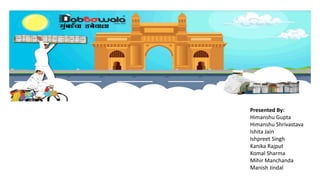Mumbai dabbawalas
- 1. Presented By: Himanshu Gupta Himanshu Shrivastava Ishita Jain Ishpreet Singh Kanika Rajput Komal Sharma Mihir Manchanda Manish Jindal
- 2. INTRODUCTION: âĒ Since 1890, Dressed in white outfit and traditional Gandhi Cap, Mumbai Army of 5,000 Dabbawalas fulfilling the hunger of almost 200,000 Mumbaikar with home-cooked food that is lug between home and office daily. âĒ The work doesnât end here, they also carry the empty lunch boxes back to the homes of the customers. âĒ The unbelievable part is that they make only one mistake in sixteen million transactions and have been consistently good at it for all the time of their operations. âĒ This credibility earned them a six sigma designation by the Forbes magazine and ISO 9001 accreditation.
- 3. âĒ Households collection and assembling at Reported collection point. âĒ Gathering at nearest aggregation point. âĒ Lunch boxes transported. âĒ Dabbas reached their Destination Zones. âĒ Food is delivered and Reverse process is initiated. Supply Chain:
- 4. Aggregation and sorting at stations Home Home Home Railway Station Office Office Office Office Pickup at homes Drop off at stations Pickup by local Dabbawalas. Delivery Collection point Process is reversed in same manner Home
- 5. CODING SYSTEM: VLP: Vile Parle (Suburb in Mumbai)/ Residential Station. 9EX12: Code for Dabbawalas at destination, different for each customer. EX: Express Towers/ Name of the building or office. 12: floor number. E: code for Dabbawalas at residential station. 3: code for destination station. Dâsouza: Name/Surname of the customer.
- 6. âĒ On time and uninterrupted service delivery even in the times of bad weather. âĒ No error inspite of lunch boxes changing hands 5 times. âĒ They do not depend or use any modern day technology for carrying out their operations. âĒ Six Sigma designated organization. âĒ Customer satisfaction is almost 100 percent. Key Features:






